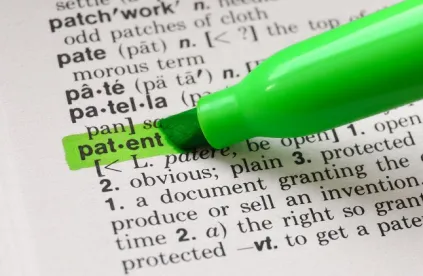The U.S. Constitution guarantees due process before a person can be deprived of life, liberty, or property. The Administrative Procedure Act (APA) enforces the due process protection in the USPTO and Board proceedings. Under the APA, each party is entitled to receive a timely notice of facts and arguments from the Board and an opportunity to be heard.[i] But what Board actions meet these requirements? The Federal Circuit has provided some guidance, and we expect there is more to come.
The notice and opportunity-to-be-heard requirements prohibit the Board from changing theories midstream without giving the respondents a reasonable notice of the change and an opportunity to present arguments under the new theory. [ii] The boundaries of Board actions have been challenged by many adversely affected parties at the Federal Circuit. But the challenging party must first try to raise the due process violation before the Board.[iii]
How egregious does the Board’s action have to be to violate due process? To answer this, let’s start with the current boundaries. The Board’s final decisions are not limited by its institution decisions, such that the Board is not required to anticipate or predict and set forth in its institution decision every legal and factual issue that might arise in the course of the proceeding.[iv] All that is required is that the Board provide a notice of its legal and factual holdings and an opportunity to respond at a meaningful point in the proceeding.[v]
The Federal Circuit found that the Board did not violate the patent owner's procedural protection when it used in its final decision a reference that was originally used as a primary reference in the petition but in a non-instituted ground.[vi] Why was this? First, the Board used the reference merely to reinforce its reasonable expectation argument and the use "was not inconsistent with" the review of the reference in the institution decision. Additionally, the parties had debated the relevance of the reference for motivation to combine art and reasonable expectation of success throughout the proceeding, including in the post-institution expert declarations and depositions and at the hearing.
Yet the Federal Circuit held that the Board denied the patent owner notice when the Board used a reference in its final decision in a manner not used in the petition or the institution decision.[vii] Here, the Board applied the reference against the claims for which it was not used in the detailed claim charts in the petition. This was true even though the reference was cited against all the claims in the petition, and specifically used against other claims.
Similarly, the Board is not per se prohibited from using a prior art reference or an argument in its final decision that was first raised after initiation of trial because the patent owner was on notice and had opportunity to respond at a meaningful point of the procedure.[viii] For example, the Federal Circuit held that the Board did not violate the patent owner's procedural protection when it used the alleged new references from the petitioner's reply in its final decision to show the state of the art at the time of the invention.[ix] The reply put the patent owner on notice since the petitioner's reply used the reference to rebut the patent owner's challenges to the petition. The patent owner was also afforded the opportunity to respond to the references during oral hearing when it acknowledged that the references may be used to show the state of the art. Beyond that, the Board's regulations provided a procedural mechanism to respond to evidence raised in the petitioner's reply such as a motion to exclude the reference. In any event, the Board may consider a prior art reference to show the state of the art at the time of the invention, regardless of whether the reference was cited in the institution decision.
However, the Federal Circuit held the Board violated the patent owner's procedural protection by adopting in its final decision a factual assertion on a prior art reference that the petitioner introduced only at the oral argument, when the patent owner could not have meaningfully supplied the rebuttal evidence.[x]
Gray areas remain with regard to claim construction. Below are two examples where the Court reached opposite decisions.
First, the Federal Circuit held that the Board didn’t deny the patent owner due process by adopting a construction in its final decision that it first discussed during oral argument and neither party had proposed. The court reasoned that the parties extensively argued the claim construction before and during the oral argument and the patent owner had the opportunity to seek a surreply or rehearing. [xi]
Second, the Federal Circuit found that the Board erred by adopting sua sponte a new construction in its final decision that was significantly different from its interpretation in the institution decision, which neither party had challenged in their briefs or at oral hearing.[xii]
In the end, this appears to be an unresolved area of law and under continued development. But it is clear that a party's vigilance in challenging violations during PTAB trial and proper framing of due process violation during the appeal process is critical to achieving success at the Federal Circuit.
[i] The Board must provide the “persons entitled to notice of an agency hearing” a timely notice of “the matters of fact and law asserted” and give “all interested parties” an opportunity to submit facts and arguments. 5 U.S.C. §§ 554(b)–(c), 557(c); Novartis AG v. Torrent Pharamceuticals, 853 F.3d 1316, 1324 (Fed. Cir. 2017); Dell Inc. v. Acceleron, LLC, 818 F.3d 1293, 1301 (Fed. Cir. 2016); SAS Institute, Inc. v. ComplementSoft, LLC, 825 F.3d 1341, 1351 (Fed. Cir. 2016); Belden Inc. v. BerkTek LLC, 805 F.3d 1064, 1080 (Fed. Cir. 2015).
[ii] Novartis AG, 853 F.3d at 1324; SAS Institute, 825 F.3d at 1351; Belden, 805 F.3d at 1080.
[iii] Securus Technologies, Inc. v. Global Tel*Link Corporation, 685 Fed.Appx. 979, 985 (Fed. Cir. 2017) (unpublished) (citing Belden, 805 F.3d at 1081).
[iv] Securus, 685 Fed.Appx. at 985; Genzyme Therapeutic Products Limited Partnership v. Biomarin Pharmaceutical Inc., 825 F.3d 1360, 1367 (Fed. Cir. 2016).
[v] Id.
[vi] Novartis, 853 F.3d at 1324 - 1326.
[vii] EmeraChem Holdings, LLC v. Volkswagen Group of America, Inc., 859 F.3d 1341, 1348 - 1352 (Fed. Cir. 2017).
[viii] Genzyme, 825 F.3d at 1367.
[ix] Id. at 1367 - 1369.
[x] Dell Inc. v. Acceleron, LLC, 818 F.3d 1293, 1301 (Fed. Cir. 2016).
[xi] Intellectual Ventures II LLC v. Ericsson Inc., 686 Fed.Appx. 900, 904 - 906 (Fed. Cir. 2017)
[xii] SAS Institute, 825 F.3d at 1350 - 1352.





 />i
/>i
